 (1)
(1)
摘要 基于Davidson-Cole模型提取极化响应的弛豫强度、弛豫时间及电导损耗等特征量,分析热氧老化过程中核级低压电缆绝缘各特征量的变化规律,阐明老化过程中微观与宏观性能下降的一致性。首先在165℃下对试样进行人工加速老化实验,获得不同劣化程度的试样,测试老化过程中试样理化特性、力学特性与介电响应的变化规律,发现老化过程中试样发生再交联反应,老化后期氧化反应加速进行;然后利用Davidson-Cole介电模型提取弛豫与电导特征参数,发现分子链段运动弛豫强度Δεα、热离子弛豫强度Δεδ与直流电导率σdc随老化时间增加呈逐渐下降趋势,老化504 h后,氧化反应的加速进行减缓了Δεα与σdc的下降,再交联反应对特征参数的变化起主导作用;最后对介电模型特征参数Δεα、Δεδ、σdc与断裂伸长率进行初步拟合,结果显示Δεα、Δεδ和σdc与断裂伸长率呈正相关,可见频域介电谱的定量分析可应用于低压电缆老化状态评估。
关键词:低压电缆 热氧老化 介电响应 Davidson-Cole模型
低压电缆广泛应用于核电站中电力的传输、数据与信号通信、仪器仪表的控制等方面[1-3]。电缆在运行过程中会受到温度、辐射、机械应力等多种因素的影响,随着服役时间的增加,电缆材料逐渐劣化,严重时会引发危害电缆运行的安全问题。对于运行在核反应堆安全壳以外的电缆,热与氧的作用是其老化的主要因素,因此有必要深入探究低压电缆的热氧老化机制与劣化规律[4-5]。
传统用于评估低压电缆绝缘状态的最常见的标准是力学参量,主要是断裂伸长率(Elongation at Break, EAB),然而拉伸实验是破坏性的局部测量,不能反映电缆的整体绝缘状态[6]。近年来,频域介电谱法作为新型无损诊断技术,具有非破坏性、操作简单等优点,适宜电缆的整体绝缘状态表征。国内外学者开展了大量的研究工作,探索温度、辐射等因素对电缆频域介电谱特性的影响[7-16]。这些研究重点着眼于定性地分析频域介电谱随各种影响因素的变化规律,因此,寻找一种合理的介电物理模型拟合低压电缆的复介电常数曲线,提取特征参量,是实现频域介电谱特性定量分析的有效手段。
介电响应特征作为聚合物材料的关键性能指标,与电介质材料极化与电导损耗有关,受热氧老化对分子链段运动弛豫极化、热离子弛豫极化、直流电导等性能有显著影响。K. S. Cole和R. H. Cole在经典Debye弛豫模型基础上提出了著名的Cole-Cole模型,并使模型适用性拓展至更多电介质材料[17]。杨丽君等采用修正Cole-Cole模型分析了不同温度及水分含量对油纸绝缘介电模型参数的影响[18-19]。刘骥等给出了老化评估中油纸绝缘Davidson-Cole模型参数的提取方法,进一步验证了介电模型在绝缘状态定量分析上的应用[20]。闵道敏等针对核级电缆开展老化研究,发现核电缆存在两个弛豫过程,并采用Cole-Cole模型获得了热膨胀系数、介电弛豫强度等特征参数与辐照剂量的关系[21-22]。目前,将Davidson-Cole介电模型应用在低压电缆热氧老化过程中频域介电谱的参数变化规律的研究鲜有报道,因此,采取科学的介电模型分析低压电缆介电响应特性,同时分析介电响应特征参数与材料老化状态的相关性,具有重要的工程意义与研究价值。
由于核电缆的特殊使用环境,电缆绝缘要求具有低烟无卤阻燃功能。阻燃交联聚烯烃作为我国第三代核电缆研发的重要绝缘材料,其阻燃剂成分占比较高(约占60%),阻燃交联聚乙烯(Polyethylene, PE)/乙烯-醋酸乙烯酯共聚物(Ethylene-Vinyl Acetate copolymer, EVA)可以显著地提升聚合物的力学性能与填料的承载能力,受到了各国学者的广泛关注[4,23-25]。本文针对辐照交联PE与EVA共混物开展热氧老化实验,测试了试样在不同老化时间下的理化特性和力学特性,基于Davidson-Cole模型分析电缆不同老化时间下介电响应特性,提取介电弛豫强度、直流电导率等特征参数,探究不同老化时间下理化特性、力学特性与阻燃交联聚烯烃材料介电响应特征的影响规律和机制,为低压电缆老化研究提供实验和理论依据。
聚合物的结构复杂,分子量的分散性及相邻链间的协同作用使其具有更宽的弛豫时间分布,在适用于单一弛豫时间的线性介质的Debye弛豫模型基础上,通过引入弛豫形状参数γ,得到电介质Cole-Cole弛豫模型[17]为
 (1)
(1)
式中,ω为角频率;εs为试样静态介电常数;εhf为试样高频介电常数;τ为弛豫时间常数;弛豫形状参数γ满足0<γ≤1。
Davidson和R. H. Cole通过实验观察,在Cole-Cole模型基础上发现部分聚合物符合另一种弛豫时间分布,引入弛豫形状参数β(0<β≤1),提出了Davidson-Cole模型[26],即
 (2)
(2)
在聚合物复介电常数表征中,进一步考虑电介质材料中直流电导率 的影响,尤其在高温低频时对介质损耗影响最大[26]。同时,在试样中可能存在多个弛豫过程,以双弛豫过程为例,复介电常数可改写为
的影响,尤其在高温低频时对介质损耗影响最大[26]。同时,在试样中可能存在多个弛豫过程,以双弛豫过程为例,复介电常数可改写为
 (3)
(3)
式中,Δεδ、τδ、βδ分别为弛豫过程δ的介电弛豫强度、介电弛豫时间常数及形状参数;Δεα、τα、βα分别为弛豫过程α的介电弛豫强度、介电弛豫时间常数及形状参数;ε0为真空下的介电常数,ε0=8.854× 10-12 F/m;σdc为试样的直流电导率[27-29]。
试样为国内某核电公司按照试运行低压电缆(K3级)配方1:1代加工制得,其中主要成分为PE与EVA(质量比为PE:EVA=7:10)、助交联剂、抗氧剂、低烟无卤阻燃剂等,经平板热压法制得厚度约为1 mm的试样,最后进行辐照交联处理,剂量为100 kGy(1 Gy=1 J/kg)。根据标准IEC 60216-1:2013与GB/T 11026.1—2016对样品在165 ℃温度下进行人工加速老化实验,在老化时间为0、48、168、336、504、672、840 h取出样品用于后续实验分析[4]。
2.2.1 红外光谱实验
采用日本SHIMADZU生产的IR Prestige-21型红外光谱仪分析老化过程对试样化学结构的影响。采用衰减全反射(Attenuated Total Reflection, ATR)模式,扫描范围为4 000~500 cm-1,分辨率为4 cm-1,扫描次数为32。
2.2.2 凝胶含量实验
采用萃取法测试试样老化过程中大分子网络的变化。首先称重(0.3±0.01) g试样,将120目不锈钢网制成方形口袋状;然后将试样装入不锈钢网中,制成方形网包;最后将网包放入盛有二甲苯的圆底烧瓶中,冷凝回流萃取24 h。萃取结束后将网包放入80 ℃真空烘箱中干燥48 h至恒重。考虑到复合试样中无机填料在萃取前后质量基本不变[30],本文对PE与EVA的凝胶含量G进行测试,表达式为
 (4)
(4)
式中,m1为不锈钢网质量;m2为网包质量;m3为干燥后网包质量;Xc为试样中PE与EVA的质量分数。每种试样进行两次测试,取凝胶含量平均值作为最终结果。
2.2.3 宽频介电谱实验
采用德国Novcontrol 公司生产的Concept 80宽频介电谱系统分析老化过程对试样介电性能的影响。首先在试样表面溅射直径分别为30 mm、40 mm的圆形金电极,然后将试样放置在烘箱内在50℃的条件下进行预处理12 h,用于去除试样附着的水分。测试电压为1 V,测试温度为100℃,测试频率为10-1~106 Hz。
2.2.4 拉伸实验
采用美斯特工业系统的5kNCMT—4503万能电子拉力机对试样进行拉伸测试,根据标准IEC IEEE 62582—3—2012,将试样加工成哑铃形样条,拉伸速率设置为20 mm/min,每种试样进行5次测试,取断裂伸长率的平均值作为该试样的最终结果。
3.1.1 傅里叶红外光谱
热氧作用会引起聚合物材料的化学结构变化,不同老化时间下试样的红外光谱如图1所示。其中,2 919 cm-1和2 849 cm-1为亚甲基(—CH2)伸缩振动峰、1 463 cm-1为亚甲基变角振动峰。EVA中存在典型的1 736 cm-1酯基吸收振动峰,1 700~1 750 cm-1羰基峰为本征基团与老化产物的叠加。试样在老化672 h、840 h时振动峰显著减小,这是由于ATR模式会受到试样表面硬度的影响,吸收峰减弱[31-32]。为了定量探究试样热氧老化过程中羰基的变化规律,本文将1 700~1 750 cm-1与1 463 cm-1峰面积(见图1中虚线框部分)之比定义为羰基指数,用以观察EVA中乙酸乙烯酯基团的降解及试样的氧化程度[2,6],每种试样进行3次红外光谱测试,取羰基指数的平均值作为最终结果。
热氧老化过程中试样的羰基指数变化规律如图2所示,发现在老化504 h以前,试样的羰基指数逐渐减小,其中老化168 h以前羰基指数减小得最快,这主要是由热作用下EVA中乙酸乙烯酯热裂解导致。在老化进行至504 h以后,可以看到羰基指数增加,同时图1中波长1 700~1 750 cm-1范围内峰宽显著变大,在老化后期试样热降解过程中氧化反应加速进行,生成酮、醛、酯、羧酸等羰基,使吸收峰变宽,羰基指数增加[4,31,33]。
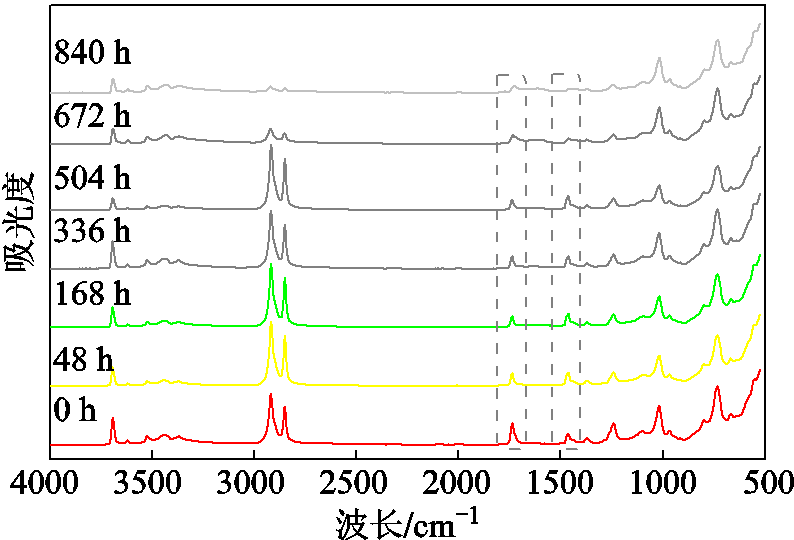
图1 不同老化时间下试样红外光谱
Fig.1 Infrared spectral absorbance of samples as a function of aging time
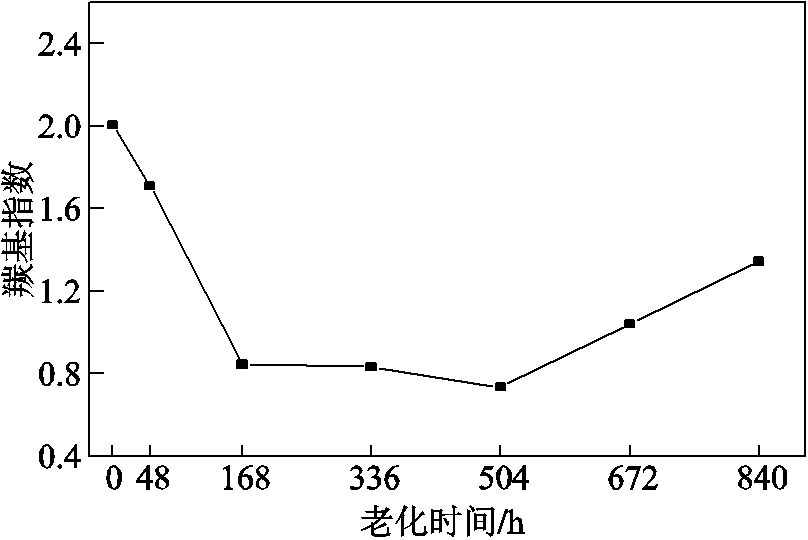
图2 不同老化时间下试样的羰基指数
Fig.2 Carbonyl index of samples as a function of aging time
3.1.2 交联度
热氧作用下试样的交联度可能会发生相应的变化,采用凝胶含量反映老化过程中试样的交联结构完整度。热氧老化过程中试样的凝胶含量变化规律如图3所示,可见随着老化时间的延长,试样的凝胶含量逐渐增加,经历840 h老化后,试样凝胶含量由初始时的53.3%增长至79.9%。分析可知,试样老化过程中因分子链断裂产生的自由基在相互作用下彼此连接,形成新的交联键,即发生了再交联反应,使试样中三维立体网状结构增加。交联度的增加使试样宏观表现变硬,这也是图1中试样在ATR模式下老化后期峰强度明显减小的主要原因[32,34]。
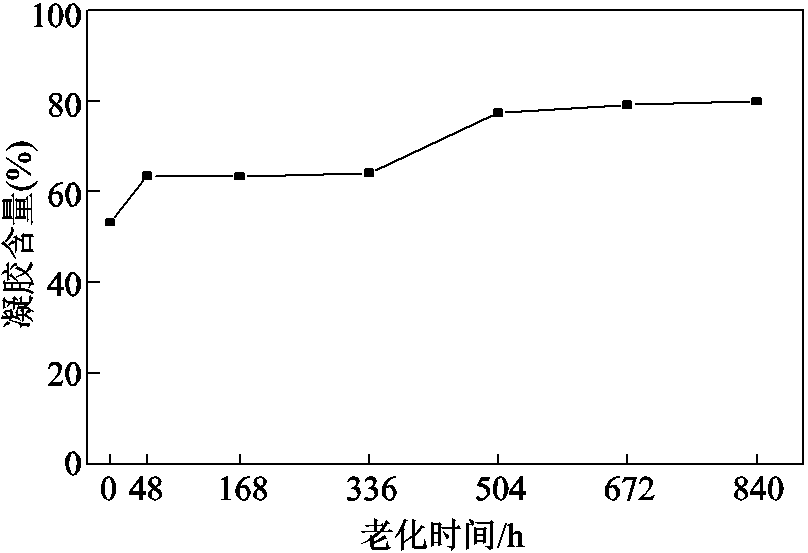
图3 不同老化时间下试样凝胶含量
Fig.3 Gel content of samples as a function of aging time
3.2.1 基于Davidson-Cole模型的介电谱分析
热氧老化会影响聚合物的介电常数与介质损耗,通过宽频介电谱分析不同老化时间对试样介电响应特性的影响。载流子的形成及迁移与温度密切相关,为了探究低频下载流子迁移形成的弛豫与电导过程,实验选择在100 ℃下进行[21,29]。不同老化时间下试样的相对介电常数 与介质损耗
与介质损耗 的频谱如图4所示。图4a中的相对介电常数在高频区(f>104 Hz)趋向一定值,这是由试样在交流电场下发生的电子位移、原子位移等极化引起的。图4b在中频区(102~104 Hz)出现一个损耗峰,这是试样中分子链段运动引起的,即弛豫过程α。从图4中还可看出,低中频区(10-1~102 Hz)试样的相对介电常数及介质损耗随着频率降低逐渐增大,直流电导是介质在高温低频下引起介质损耗的主要原因,其在对数坐标下斜率应为-1,而图4b中介质损耗在对数坐标系下的曲线斜率大于-1,因此试样在中低频区存在另一个弛豫过程δ。中低频区复介电常数的变化是由离子跃迁引起的,一方面,离子在交流电场作用下定向迁移形成离子电导;另一方面,离子由于热运动作用越过势垒发生定向迁移引起弛豫极化[22,29]。热氧老化对试样复介电常数的影响显著,相对介电常数
的频谱如图4所示。图4a中的相对介电常数在高频区(f>104 Hz)趋向一定值,这是由试样在交流电场下发生的电子位移、原子位移等极化引起的。图4b在中频区(102~104 Hz)出现一个损耗峰,这是试样中分子链段运动引起的,即弛豫过程α。从图4中还可看出,低中频区(10-1~102 Hz)试样的相对介电常数及介质损耗随着频率降低逐渐增大,直流电导是介质在高温低频下引起介质损耗的主要原因,其在对数坐标下斜率应为-1,而图4b中介质损耗在对数坐标系下的曲线斜率大于-1,因此试样在中低频区存在另一个弛豫过程δ。中低频区复介电常数的变化是由离子跃迁引起的,一方面,离子在交流电场作用下定向迁移形成离子电导;另一方面,离子由于热运动作用越过势垒发生定向迁移引起弛豫极化[22,29]。热氧老化对试样复介电常数的影响显著,相对介电常数 在低中频区(10-1~102 Hz)随着老化时间增加而逐渐减小,介质损耗
在低中频区(10-1~102 Hz)随着老化时间增加而逐渐减小,介质损耗 在10-1~104 Hz频域范围内随老化时间延长逐渐减小,其中,老化初期试样的复介电常数变化较明显。
在10-1~104 Hz频域范围内随老化时间延长逐渐减小,其中,老化初期试样的复介电常数变化较明显。

图4 不同老化时间下试样复介电常数频谱
Fig.4 The complex permittivity spectras of samples as a function of aging time
基于以上的分析,试样在较高温度时存在两个弛豫过程α与δ,同时考虑直流电导率σdc的影响,本文采用Davidson-Cole介电弛豫模型来表示试样在不同老化时间下的复介电常数ε∗,如式(3)所示。通过Matlab编程,采用最小二乘法对试样的介电频域谱进行拟合,得到试样复介电常数的实虚部拟合曲线[18-20]。
热氧老化48 h时,试样复介电常数实部(相对介电常数)与虚部(介质损耗)的实验及拟合结果对比如图5所示,可以看出试样的拟合程度较好,其中形状参数βδ与βα分别为0.59±0.005和0.3±0.005。从图5a中可以看出,弛豫过程δ及试样高频相对介电常数εhf对相对介电常数贡献较大;从图5b中看出,直流电导率σdc及弛豫过程δ在介质损耗中低频区占主导作用,而在高频区弛豫过程α的贡献较大。下面针对Davidson-Cole介电模型中特征参数Δεα、Δεδ、σdc与老化时间的关联性进行讨论。
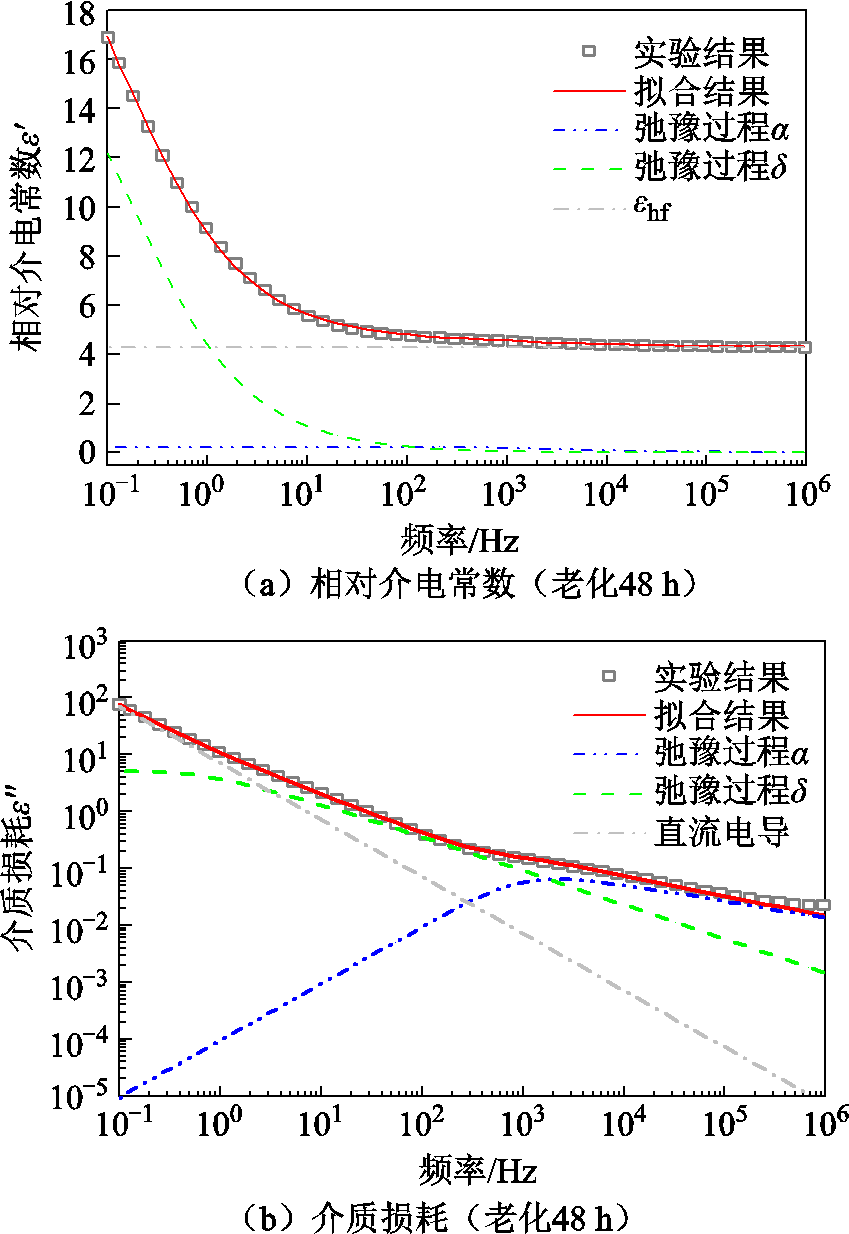
图5 试样老化48 h复介电常数实验与拟合结果对比
Fig.5 Comparison between experimental and calculated results of the sample aged for 48 h
3.2.2 分子链段运动弛豫分量
试样分子链段运动弛豫强度∆εα随老化时间的变化规律如图6所示,可见Δεα随老化时间的延长逐渐下降,其中Δεα在老化初期下降较为明显,在老化进行168 h时已下降至初始值的61.1%。在热氧条件下的分子链段运动弛豫强度变化可以用自由体积理论来解释[26]。聚合物自由体积在广义上为无定形区未被分子链占据的部分体积。在热氧老化初始阶段,试样发生再交联反应,自由体积减少,限制了分子链段运动,使分子链段运动弛豫强度Δεα在老化初期降低[21,26]。老化中期试样的分子链段弛豫强度略降低,是由于抗氧剂的作用抑制了试样的热氧老化过程,使老化进行缓慢。在504 h以后,交联反应与氧化反应二者相互竞争,热氧降解导致的分子链断裂及氧化产物生成使Δεα相较于老化初期下降减缓。在整个老化过程中,交联在分子链段运动的强度变化上占主导地位。
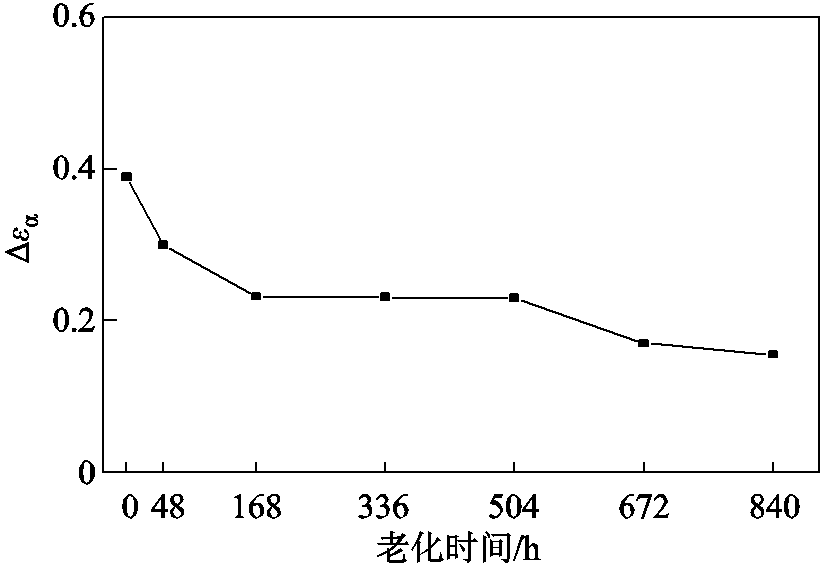
图6 试样不同老化时间下弛豫强度Δεα
Fig.6 Relaxation strength Δεα of samples as a function of aging time
试样中不同尺寸的分子链段有着不同的弛豫时间常数,从而形成了一个较宽的弛豫时间分布。进一步探究分子链段运动弛豫时间分布特性,Davidson-Cole介电模型的弛豫时间分布关系式为
 (5)
(5)
式中,fα(t)为弛豫过程α的弛豫时间分布函数;t为弛豫过程α的弛豫时间。本文中将弛豫时间t大于弛豫时间常数τα部分的函数值计为0[28]。
分子链段运动弛豫过程的弛豫时间分布如图7所示,可以看出,随着老化的进行,弛豫时间逐渐增加,对应着损耗峰向低频处偏移。这种变化趋势与试样交联程度紧密相关,自由体积的减小限制了分子链段的运动,弛豫时间在老化过程中逐渐增加。相较于弛豫强度∆εα,弛豫时间分布fα(t)在老化过程中总体变化程度较小。
3.2.3 热离子弛豫极化及直流电导分量
介电弛豫强度Δεδ随热氧老化时间的变化如图8所示。从图8可以看出,介电弛豫强度Δεδ在老化过程中呈逐渐下降的趋势,在老化进行至840 h时,Δεδ已下降为初始值的49.1%。试样中存在的离子主要源于填料中的杂质,离子受热越过束缚势垒形成宏观偶极矩,在交变电场下形成热离子弛豫极化[35]。随着老化的不断进行,试样交联度增加,大分子网状结构的增加使离子跃迁受阻,热离子弛豫强度下降。
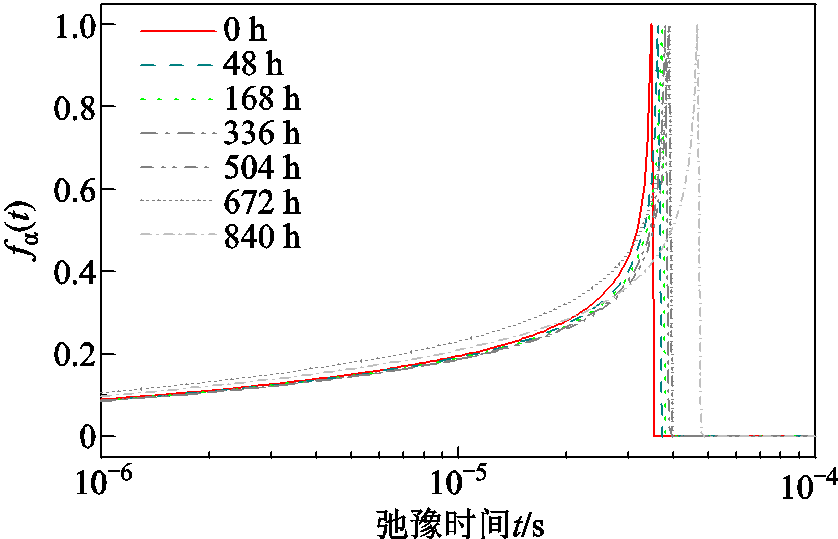
图7 试样不同老化时间下弛豫时间分布
Fig.7 The distribution of relaxation time of samples as a function of aging time
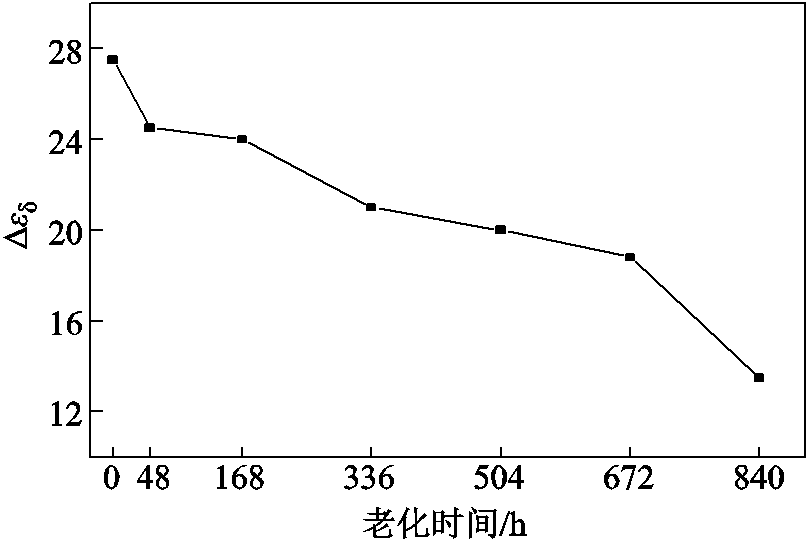
图8 试样不同老化时间下弛豫强度Δεδ
Fig.8 Relaxation strength Δεδ of samples as a function of aging time
试样直流电导率σdc随热氧老化时间的变化如图9所示。可以看出,直流电导率σdc在老化过程中逐渐减小,在504 h前σdc下降较快,504 h后下降趋势逐渐减缓。高聚物中的电导包括离子电导与电子电导,其中,低电场高温下主要是离子电导[26]。同时本文中试样是阻燃交联聚烯烃,因此试样的电导主要来源于杂质离子[36]。随着热氧老化的不断进行,试样的分子间交联键增多,分子间相互作用增加,显著抑制了离子的定向迁移,试样的电导率降低。在504 h后,氧化反应不断进行,氧化产物的增加使载流子浓度有所提升,而交联度进一步提升,抑制了载流子的迁移,二者竞争机制下σdc相较于老化初期下降趋势减缓。在整个老化过程中,交联度作为关键因素,对试样载流子迁移变化起主导作用。
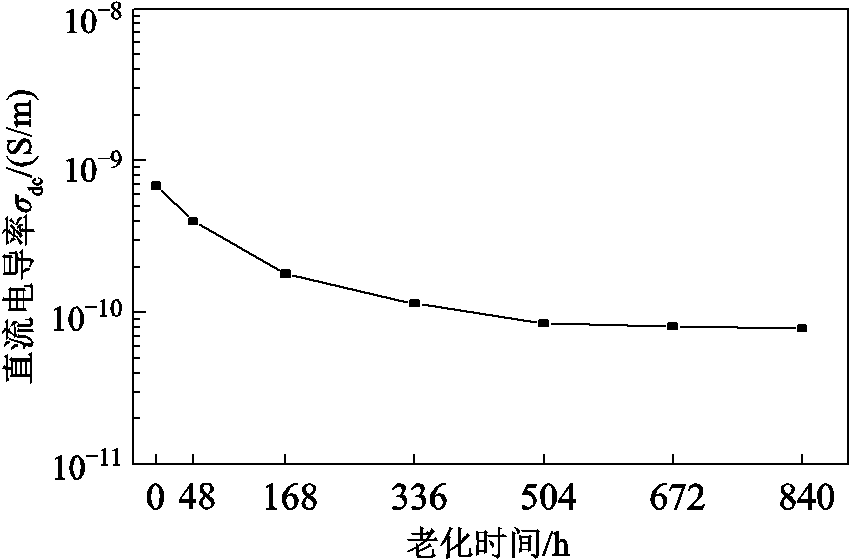
图9 试样不同老化时间下直流电导率σdc
Fig.9 DC conductivity σdc of samples as a function of aging time
断裂伸长率作为核电站电缆绝缘寿命的传统标准,对热氧老化具有优异的敏感度。图10给出了不同老化时间下试样断裂伸长率随老化时间的变化规律。从图10可以看出,配方电缆试样初始断裂伸长率为185.16%,试样的断裂伸长率在老化504 h以前总体呈小幅下降趋势,在老化504 h以后,试样断裂伸长率快速下降,材料力学性能被严重破坏。核级电缆的特殊性使试样中添加了大量的阻燃剂,尽管试样初始力学性能相比交联聚乙烯(Cross Linked Polyethylene, XLPE)、交联EVA有所下降,但仍保持了较好的抗撕裂性[23]。高聚物材料的断裂伸长率主要取决于材料中的大分子柔性,在老化504 h以前,试样发生再交联反应,交联度的提升引起试样大分子网络结构增加,材料柔性降低,阻碍了分子链段运动导致难以实现高弹形变,此时试样变脆,断裂伸长率下降[8,15,26]。在老化504 h以后,从图2可知氧化反应加速进行,氧化产物逐渐增多,同时交联度的进一步提升均使试样大分子柔性降低,断裂伸长率急剧下降。根据国际原子能机构(Inter- national Atomic Energy Agency, IAEA)的建议,通常采用试样的断裂伸长率下降为初始值的50%时作为该试样的机械标准失效时间,即试样在672 h时可判定为失效[37-38]。
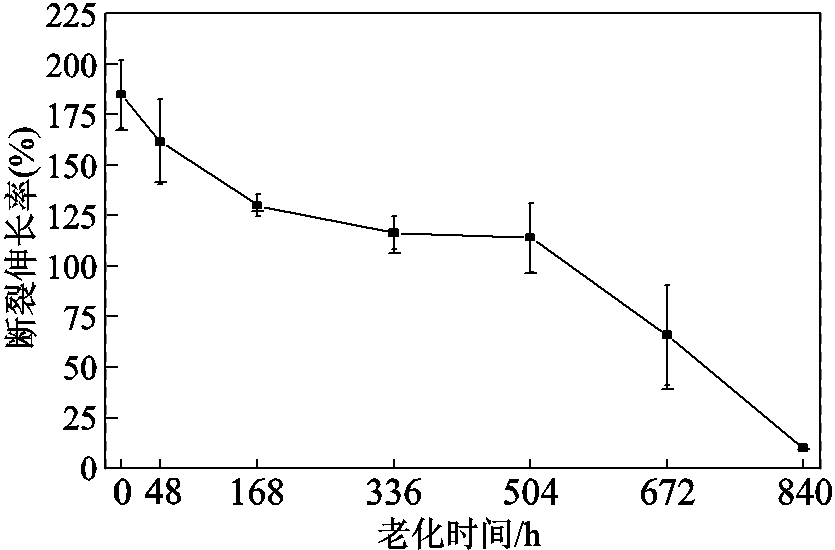
图10 不同老化时间下试样断裂伸长率
Fig.10 Elongation at break of samples as a function of aging time
介电模型特征参数随老化时间的单调变化如图6、图8、图9所示,进一步探究特征参数与传统状态评估标准的相关性,图11给出了断裂伸长率与Δεα、Δεδ、σdc的初步拟合结果。从图11可以看出,弛豫强度Δεα、Δεδ和直流电导率σdc与断裂伸长率呈现较好的正相关性。凝胶含量作为关键参数,在老化过程中逐渐增加,试样交联度的提升抑制了离子的迁移,试样自由体积减小,大分子柔性降低,显著改变了试样的介电特性与力学特性,使介电特征参数与力学参数具有一致性。通过建立二者的联系,表明Davidson-Cole介电模型可以成为低压电缆热氧老化机制及状态评估的有利工具。
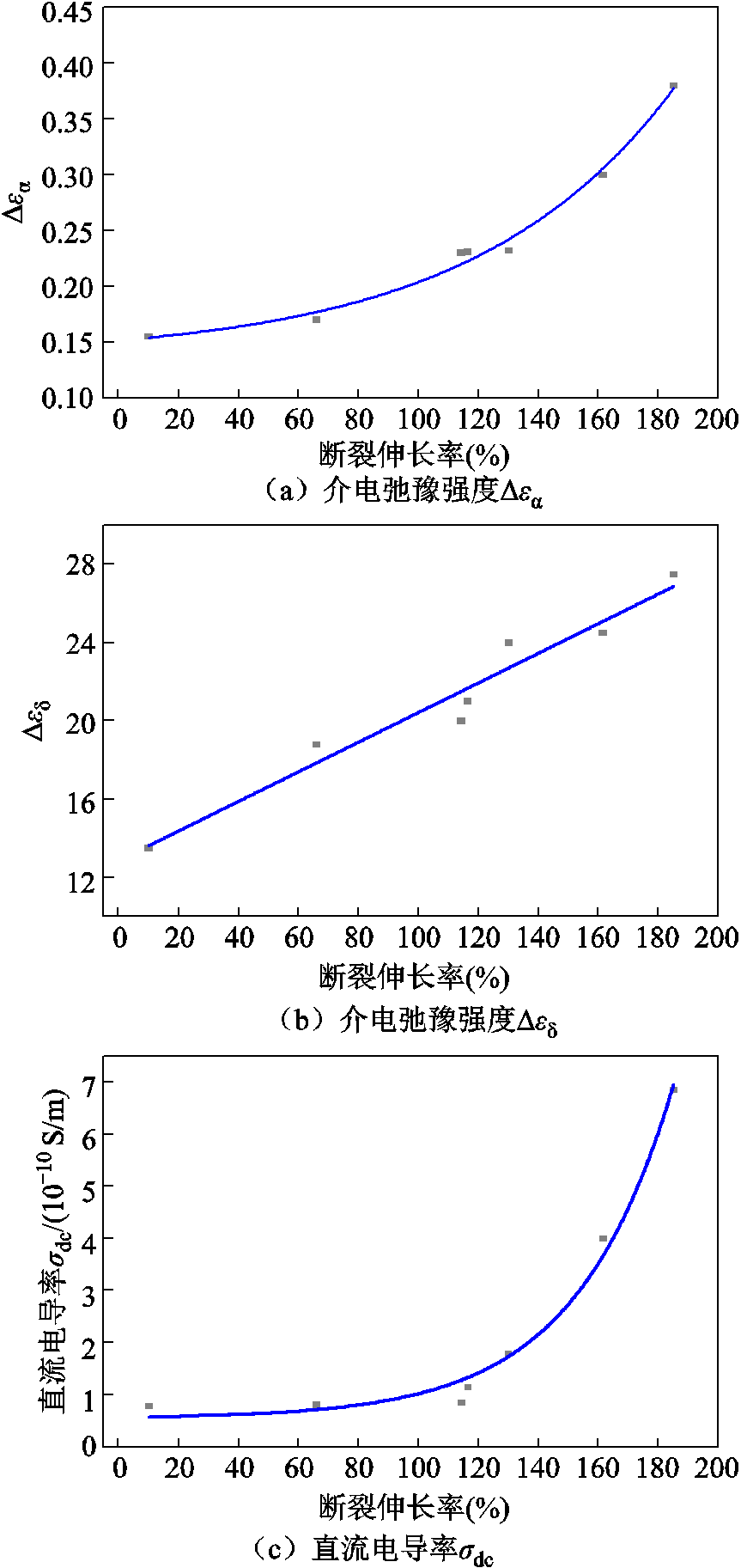
图11 试样断裂伸长率与特征参数相关性
Fig.11 The relationship between the elongation at break and the characteristic parameters of samples
本文采用红外光谱、凝胶含量实验、拉伸实验、频域介电谱研究了低压电缆热氧老化过程中的理化特性、力学特性与介电响应特性的变化规律及关联性,得到的主要结论如下:
1)试样在老化前期羰基指数的减小源于乙酸乙烯酯的降解,504 h后热氧反应加速进行,羰基指数增加,同时试样在老化过程中发生再交联反应。
2)老化过程中试样的再交联反应对介电模型特征参数的变化起主导作用,分子链段运动弛豫强度Δεα、热离子弛豫强度Δεδ与直流电导率σdc随着老化时间的增加逐渐下降。其中,504 h后分子链的氧化反应加速进行,使Δεα与σdc下降趋势减缓。
3)随着老化时间延长,试样断裂伸长率下降显著,在672 h时判定失效,初步验证了Davidson-Cole介电模型特征参数与断裂伸长率具有良好的相关性。
本文揭示了不同老化程度下介电响应特征参数的定量变化规律及其与理化特性、力学特性的联系,发现频域介电谱的定量分析不仅可以表征材料的介电响应机理,而且与断裂伸长率具有强关联性,在低压电缆状态与寿命评估应用方向具有广阔的发展前景。
参考文献
[1] Powers W F. The basics of power cable[J]. IEEE Transactions on Industry Applications, 1994, 30(3): 506-509.
[2] Suraci S V, Fabiani D, Xu A, et al. Ageing assessment of XLPE LV cables for nuclear applications through physico-chemical and electrical measurements[J]. IEEE Access, 2020, 8: 27086-27096.
[3] 周涛, 秦雪猛, 李子超, 等. 核电缆发展分析研究[J]. 黑龙江电力, 2018, 40(4): 283-286. Zhou Tao, Qin Xuemeng, Li Zichao, et al. Analysis and research of nuclear cable development[J]. Heilongjiang Electric Power, 2018, 40(4): 283-286.
[4] Chi Xiaohong, Li Jianxi, Ji Minzun, et al. Thermal-oxidative aging effects on the dielectric properties of nuclear cable insulation[J]. Materials, 2020, 13(10): 2215.
[5] 曹丹, 孙彬, 单永东, 等. 核电用交联三元乙丙绝缘材料热氧老化状态的评估[J]. 合成材料老化与应用, 2019, 48(3): 1-5, 63. Cao Dan, Sun Bin, Shan Yongdong, et al. Evaluation of thermal oxygen aging status of crosslinked EPDM insulation materials for nuclear power[J]. Synthetic Materials Aging and Application, 2019, 48(3): 1-5, 63.
[6] Suraci S V, Fabiani D, Roland S, et al. Multi scale aging assessment of low-voltage cables subjected to radio-chemical aging: towards an electrical diagnostic technique[J]. Polymer Testing, 2021, 103: 107352.
[7] 杜伯学, 韩晨磊, 李进, 等. 高压直流电缆聚乙烯绝缘材料研究现状[J]. 电工技术学报, 2019, 34(1): 179-191. Du Boxue, Han Chenlei, Li Jin, et al. Research status of polyethylene insulation for high voltage direct current cables[J]. Transactions of China Electro-technical Society, 2019, 34(1):179-191.
[8] 周凯, 李诗雨, 尹游, 等. 退运中压XLPE和EPR电缆老化特性分析[J]. 电工技术学报, 2020, 35(24): 5197-5206. Zhou Kai, Li Shiyu, Yin You, et al. Analysis of aging characteristics of medium voltage XLPE and EPR retired cables[J]. Transactions of China Electro-technical Society, 2020, 35(24): 5197-5206.
[9] Glass S W, Fifield L S, Dib G, et al. State of the art assessment of NDE techniques for aging cable management in nuclear power plants FY2015[R]. Pacific Northwest National Lab, Richland, WA, USA, 2015.
[10] Linde E, Verardi L, Fabiani D, et al. Dielectric spectroscopy as a condition monitoring technique for cable insulation based on crosslinked polyethylene[J]. Polymer Testing, 2015, 44: 135-142.
[11] 刘刚, 刘斯亮, 金尚儿, 等. 基于理、化、电特性的110 kV XLPE绝缘电缆剩余寿命的综合评估[J]. 电工技术学报, 2016, 31(12): 72-79, 107. Liu Gang, Liu Siliang, Jin Shanger, et al. Comprehensive evaluation of remaining life of 110 kV XLPE insulated cable based on physical, chemical and electrical properties[J]. Transactions of China Electrotechnical Society, 2016, 31(12): 72-79, 107.
[12] 张益舟, 龚智明, 王雷, 等. 基于介电性能的电缆热老化及辐照老化检测技术研究[J]. 绝缘材料, 2017, 50(9): 62-67. Zhang Yizhou, Gong Zhiming, Wang Lei, et al. Thermal and irradiation ageing detection technology of cables based on dielectric properties[J]. Insulating Materials, 2017, 50(9): 62-67.
[13] 单秉亮, 李舒宁, 杨霄, 等. XLPE配电电缆缺陷诊断与定位技术面临的关键问题[J]. 电工技术学报, 2021, 36(22): 4809-4819. Shan Bingliang, Li Shuning, Yang Xiao, et al. Key problems faced by defect diagnosis and location technologies for XLPE distribution cables[J]. Transactions of China Electrotechnical Society, 2021, 36(22): 4809-4819.
[14] 王昊月, 李成榕, 王伟, 等. 高压频域介电谱诊断XLPE电缆局部绝缘老化缺陷的研究[J]. 电工技术学报, 2022, 37(6): 1542-1553. Wang Haoyue, Li Chengrong, Wang Wei, et al. Local aging diagnosis of XLPE cables using high voltage frequency domain dielectric spectroscopy[J]. Transactions of China Electrotechnical Society, 2022, 37(6): 1542-1553.
[15] 刘涛, 李欢, 徐磊, 等. 热老化对XLPE微观结构及介电性能的影响机制综述[J]. 陕西理工大学学报(自然科学版), 2021, 37(4): 1-9, 31. Liu Tao, Li Huan, Xu Lei, et al. Review of effects of thermal aging on micro-structure and performance of cross-linked polyethylene cable insulation[J]. Journal of Shaanxi University of Technology (Natural Science Edition), 2021, 37(4): 1-9, 31.
[16] Zhou Haolong, Hanafusa W, Udo K, et al. Aging behavior of flame-retardant cross-linked polyolefin under thermal and radiation stresses[J]. IEEE Transactions on Dielectrics and Electrical Insulation, 2021, 28(1): 303-309.
[17] Cole R H. Dielectric polarization and relaxation[M]// Molecular Liquids. Dordrecht: Springer Netherlands, 1984: 59-110.
[18] 杨丽君, 齐超亮, 邓帮飞, 等. 采用修正Cole-Cole模型提取油纸绝缘频域介电谱的特征参量方法[J]. 高电压技术, 2013, 39(2): 310-317. Yang Lijun, Qi Chaoliang, Deng Bangfei, et al. Application of modified Cole-Cole model to extract characteristics of frequency dielectric spectroscopy of oil-paper insulation[J]. High Voltage Engineering, 2013, 39(2): 310-317.
[19] 杨丽君, 高思航, 高竣, 等. 油纸绝缘频域介电谱的修正Cole-Cole模型特征参量提取及水分含量评估方法[J]. 电工技术学报, 2016, 31(10): 26-33. Yang Lijun, Gao Sihang, Gao Jun, et al. Characteristic parameters extracted from modified Cole-Cole model and moisture content assessment methods study on frequency-domain dielectric spectroscopy of oil-paper insulation[J]. Transactions of China Electrotechnical Society, 2016, 31(10): 26-33.
[20] 刘骥, 尹梦涵, 李秀婧, 等. 油纸绝缘老化评估的Davidson-Cole模型参数提取方法[J]. 电机与控制学报, 2017, 21(3): 63-70. Liu Ji, Yin Menghan, Li Xiujing, et al. Parameters extraction of Davidson-Cole model on aging assessment of oil-paper insulation[J]. Electric Machines and Control, 2017, 21(3): 63-70.
[21] Min Daomin, Li Shengtao, Hirai N, et al. Dielectric spectroscopic analysis of degradation in ethylene-propylene-diene copolymer[J]. IEEE Transactions on Dielectrics and Electrical Insulation, 2016, 23(6): 3620-3630.
[22] Min Daomin, Yan Chenyu, Huang Yin, et al. Dielectric and carrier transport properties of silicone rubber degraded by gamma irradiation[J]. Polymers, 2017, 9(10): 533.
[23] 马以正, 侯海林. 辐射交联无卤阻燃聚烯烃复合材料的研究[J]. 核技术, 1997, 20(7): 408-412. Ma Yizheng, Hou Hailin. Preparation of non-halogen flame retardant polyolefin complex by radiation crosslinking[J]. Nuclear Techniques, 1997, 20(7): 408-412.
[24] 丁圆, 张宏, 刘琪, 等. PE/EVA共混改性研究进展[J]. 化工时刊, 2020, 34(10): 22-24, 59. Ding Yuan, Zhang Hong, Liu Qi, et al. Research progress of PE/EVA blending modification[J]. Chemical Industry Times, 2020, 34(10): 22-24, 59.
[25] Colombani J, Sidi A, Larché J F, et al. Thermooxidative degradation of crosslinked EVA/EPDM copolymers: impact of Aluminium TriHydrate (ATH) filler incorporation[J]. Polymer Degradation and Stability, 2018, 153: 130-144.
[26] 雷清泉. 高聚物的结构与电性能[M]. 武汉: 华中理工大学出版社, 1990.
[27] 林生军, 黄印, 谢东日, 等. 环氧树脂高温分子链松弛与玻璃化转变特性[J]. 物理学报, 2016, 65(7): 304-310. Lin Shengjun, Huang Yin, Xie Dongri, et al. Molecular relaxation and glass transition properties of epoxy resin at high temperature[J]. Acta Physica Sinica, 2016, 65(7): 304-310.
[28] 康文斌, 蒙绍兴, 李世军, 等. 硅橡胶绝缘介质的分子链运动与电极极化特性[J]. 高电压技术, 2018, 44(12): 3798-3807. Kang Wenbin, Meng Shaoxing, Li Shijun, et al. Molecular chain motion and electrode polarization properties of silicone rubber[J]. High Voltage Engineering, 2018, 44(12): 3798-3807.
[29] Ohki Y. Broadband complex permittivity and electric modulus spectra for dielectric materials research[J]. IEEJ Transactions on Electrical and Electronic Engineering, 2022, 17(7): 958-972.
[30] Sidi A, Colombani J, Larché J F, et al. Multiscale analysis of the radiooxidative degradation of EVA/EPDM composites. ATH filler and dose rate effect[J]. Radiation Physics and Chemistry, 2018, 142: 14-22.
[31] 翁诗甫. 傅里叶变换红外光谱分析[M]. 2版. 北京: 化学工业出版社, 2010.
[32] Yamaguchi H, Ishii H, Hirai N, et al. Degradation of mechanical and dielectric properties of flame-retardant ethylene propylene rubber by thermal aging[J]. IEEJ Transactions on Electrical and Electronic Engineering, 2020, 15(4): 488-495.
[33] Allen N S, Edge M, Rodriguez M, et al. Aspects of the thermal oxidation of ethylene vinyl acetate copolymer[J]. Polymer Degradation and Stability, 2000, 68(3): 363-371.
[34] 何平笙. 新编高聚物的结构与性能[M]. 北京: 科学出版社, 2009.
[35] 朱诚身. 聚合物结构分析[M]. 北京: 科学出版社, 2004.
[36] 秦书娟, 徐曼, 曹晓珑, 等. EVA/VLDPE/Mg(OH)2阻燃体系介电性能研究[J]. 电线电缆, 2010(3): 31-34, 37. Qin Shujuan, Xu Man, Cao Xiaolong, et al. Study on the dielectric performance of EVA/VLDPE/Mg(OH)2 composite[J]. Electric Wire & Cable, 2010(3): 31-34, 37.
[37] International Atomic Energy Agency. Assessment and management of ageing of major nuclear power plant components important to safety: volume Ⅱin-containment instrumentation and control cables[M]. Vienna: International Atomic Energy Agency, 2000.
[38] Fabiani D, Suraci S V. Broadband dielectric spectroscopy: a viable technique for aging assessment of low-voltage cable insulation used in nuclear power plants[J]. Polymers, 2021, 13(4): 494.
Abstract The low-voltage(LV) cables in nuclear power plants would be affected by heat and oxygen under actual operation, and the cable materials would gradually deteriorate with the increase of service time. The most common standard traditionally used to evaluate the insulation state of LV cables was the mechanical parameter, mainly elongation at break (EAB), however, the tensile experiments were destructive. Rencently, frequency domain spectroscopy (FDS), as one new non-destructive diagnostic technology, had the advantages of being non-destructive and simple, and was suitable for the characterization of the overall insulation state of the cables. However, the vast majority of studies focused on qualitatively analyzing the variation of the FDS with various influencing factors. Therefore, one scientific dielectric model was used to quantitatively analyze the dielectric response characteristics of LV cables, and the correlation between the dielectric parameters and the physical, chemical, mechanical properties of the materials was discussed.
Firstly, the accelerated aging experiments were carried out on the cross-linked polyethylene (PE)/ ethylene-vinyl acetate copolymer (EVA) specimens at 165℃ to obtain the samples with different degrees of deterioration. The changes in physical and chemical properties of PE/EVA specimens were tested through the Fourier transform infrared (FTIR) spectroscopy and the gel content. The deterioration of the mechanical property was investigated through the EAB experiment, and the dielectric properties were analyzed through the FDS at 100℃. The PE/EVA specimens had two relaxation processes form the analysis of FDS, and the DC conductance was considered at the same time. Therefore, the complex permittivity spectra of the PE/EVA samples with different aging degrees were fitted by the Davison-Cole dielectric model to extract the characteristic parameters of polarization and conductance.
The results showed that the re-crosslinking reaction of the specimens occurs during the whole aging process, which increased the three-dimensional network structure. The carbonyl index of PE/EVA showed a trend of decreasing at the beginning and then increasing, which was caused by the degradation of vinyl acetate groups at the early stage and the oxidation reaction after 504 h. It was found that the relaxation strength Δεα due to the motion of segmental chains, the thermionic polarization strength Δεδ as well as the DC conductivity σdc gradually decreased with the increase of aging time through the Davidson-Cole dielectric model. The decrease of Δεα and σdc slowed down due to the accelerated oxidation reaction after 504 h. The preliminary fitting of the characteristic parameters Δεα, Δεδ, σdc of the dielectric model and the traditional state evaluation criteria EAB showed a positive correlation.
The following conclusions can be drawn from the analysis of experimental and fitting results: (1) The degree of cross-linking, as the key parameter during the aging process, is the most important determinant of the consistency between the dielectric parameters and the mechanical parameter. The increase in the degree of cross-linking of PE/EVA inhibits the migration of ions, so that the DC conductivity σdc and the relaxation strength of the samples decrease with the aging time. The free volume of PE/EVA specimens is reduced due to the augment of the macromolecular network structure, which weakens the movement of the molecular segments. At the same time, the increase of the degree of cross-linking reduces the flexibility of macromolecules of PE/EVA, and then the EAB decreases during the aging process. (2) It is found that the quantitative analysis of the frequency domain spectroscopy can not only characterize the dielectric response mechanism of the materials, but also has a strong correlation with the elongation at break, which can be better applied in the evaluation of the state and life of the LV cables.
keywords:Low-voltage cables, thermal-oxidative aging, dielectric response characteristics, Davidson-Cole model
DOI:10.19595/j.cnki.1000-6753.tces.220882
中图分类号:TM215.92
陕西省重点研发计划资助项目(2020ZDLGY09-10)。
收稿日期 2022-05-23
改稿日期 2022-07-06
王镜然 男,1998年生,硕士研究生,研究方向为低压电缆老化机理与状态评估。E-mail:wangjingran1234@stu.xjtu.edu.cn
刘文凤 女,1982年生,教授,博士生导师,研究方向为高分子电工材料,电力设备绝缘材料改性与评估。E-mail:liuwenfeng@xjtu.edu.cn(通信作者)
(编辑 李冰)